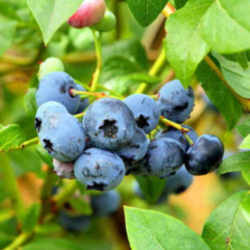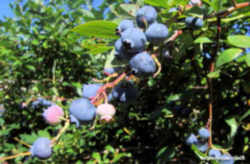Maine State Berry
Wild Blueberry

(Vaccinium angustifolium, aiton)
Adopted in 1991.
The wild blueberry, (Vaccinium angustifolium, aiton,) was adopted as Maine's state berry in 1991. Found mostly on hilly and rocky terrain, these delicious native berries were, until recently, harvested exclusively by hand using a special rake invented over 100 years ago by a Mainer (Abijah Tabbutt).
Maine's 60,000 acres of Wild Blueberries grow naturally in fields and barrens that stretch from down east to the state's southwest corner. Adapted to Maine's naturally acid, low fertility soils and challenging winters, Wild Blueberries are a low input crop requiring minimal management. The berries are grown on a two-year cycle - each year, half of a grower's land is managed to encourage vegetative growth and the other half is prepared for a Wild Blueberry harvest in August. After the harvest the plants are pruned to the ground by mowing or burning.
Description of Maine State Berry: Wild Blueberry

Harvested from late July to early September in Maine. Harvesting is still mainly by hand rake- a close-tined special RAKE invented about 112 years ago by a local Down eastern, Abijah Tabbutt and modified in minor variations since then. The secret is in the wielding of the rake - a special pushing and twisting motion of the wrists designed to tease the ripe berries from their grasp of the vine without crushing. Hand-raking is increasingly being replaced by mechanized harvesting. Although the technology is getting very good, hand-raking will always have its place - due in large part to the hilly and rocky terrain that a lot of wild blueberry patches are found on.
Characteristics of the Wild Blueberry
Vaccinium angustifolium, commonly known as the Lowbush Blueberry, is a species of blueberry native to eastern and central Canada and the northeastern United States, growing as far south as West Virginia and west to the Great Lakes region, Minnesota and Manitoba
The species name angustifolium is a combination of the Latin words angusti meaning 'narrow', and folium meaning 'leaf'. It shares this name with other species of plant including Epilobium angustifolium
Habit and Form
- a deciduous, twiggy shrub
- open, leggy crown
- 6" to 2' tall
- 2' wide
- medium texture
- moderate growth rate
Summer Foliage
- alternate leaf arrangement
- simple, deciduous shape
- lanceolate leaf shape
- 0.33" to .75" long
- serrulate leaf margins
- dark green leaf color
Autumn Foliage
- reddish, bronze fall color
- showy
Flowers
- white flowers
- 0.25" diameter
- blooms in May
- showy
Fruit
- bluish-black fruit
- sweet and edible
- up to 0.5" across
- matures in mid- to late-summer
Maine Revised Statutes
The law designating the wild blueberry as the official Maine state berry is found in the Maine Revised Statutes, Title 1, Chapter 9, Subchapter 1, Section 219.
Title 1: GENERAL PROVISIONS
Chapter 9: SEAL, MOTTO, EMBLEMS AND FLAGS
Subchapter 1: GENERAL PROVISIONS
§219. STATE BERRY
The wild blueberry (vaccinium angustifolium, aiton) is the official state berry. [1991, c. 218,
(NEW).]
SECTION HISTORY
RR 1991, c. 2, §1 (COR). 1991, c. 218, (NEW). 1991, c. 279, §2 (NEW).
Taxonomic Hierarchy: Wild Blueberry
Kingdom: Plantae - Plants
Subkingdom: Tracheobionta - Vascular plants
Superdivision: Spermatophyta - Seed plants
Division: Magnoliophyta - Flowering plants
Class: Magnoliopsida - Dicotyledons
Subclass: Dilleniidae
Order: Ericales
Family: Ericaceae - Heath family
Genus: Vaccinium L. - blueberry
Species: Vaccinium angustifolium Aiton - lowbush blueberry

List Official US State Foods







